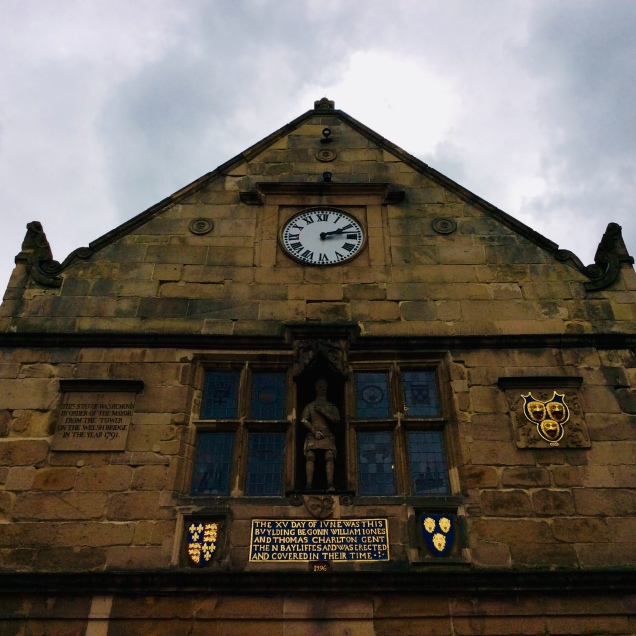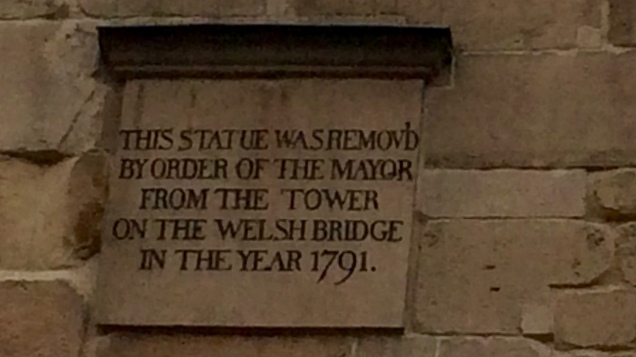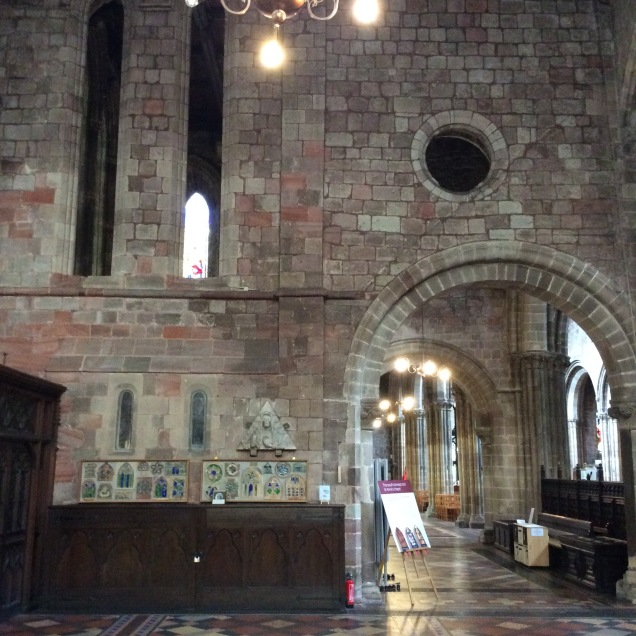
Being ideally situated on the border of England and Wales, Shrewsbury has been an important political and commercial centre for a thousand years and more. English monarch, King Edward IV and his wife, Elizabeth Woodville, at one time resided here, the birthplace of their unfortunate son, Richard of Shrewsbury, one of the two princes presumed murdered in the Tower of London. The royal connection continues with Henry VII, the first Tudor king, lodging in Shrewsbury before the Battle of Bosworth where he defeated the reputed killer of the princes, King Richard III.
The river Severn links the city to the Irish Sea via the West Country and the Bristol Channel, a key route for trade during the industrial revolution and even earlier. Many English locations are as old and historic as Shropshire’s county town, but not all have such a wealth of buildings as well preserved and still in everyday use.
On Saturday, I visited Shrewsbury for the first time. After a relaxing river sail between the Welsh and English bridges, our coach party was told where we were to reconvene at 16:45, leaving four hours to explore. Unusually for me, I had no plan for the afternoon and had just decided to wander and get a flavour of the city. I damaged my knee ligament a few weeks ago, and though I’d been walking crutch-free for over a week, I didn’t want to push my luck. I was also still feeling queasy after a terrible coach journey.

From the river we entered the city centre, passing the King’s Head pub, its sign depicting an image of King Henry VII and the date 1483, referencing the Battle of Bosworth. The current building dates from that time, just one of many timber-framed buildings from the 15th and 16th centuries. Georgian and Victorian buildings are slotted in between, with lots of passageways to explore. It isn’t a big place but the free city map was very useful in making sense of all the nooks and crannies.

We looked around the new market hall which seemed to be thriving, full of stalls selling the usual wares and a couple of small but very popular eateries, one Thai and the other serving what looked like French/Mediterranean dishes. It was lovely to see a town market doing well in an age where many, including the one in my own town, are virtually dead.
A short walk away was the old market hall, or what remained of it. The British Legion was having some sort of gathering there, and the collection of military vehicles parked in front spoiled the opportunity for photographs, but I captured the most interesting features of the front facade.




We stopped for a sandwich and another look at the map to decide our next steps. A very useful feature which I hadn’t seen on any other city maps was the little signs indicating both moderate and steep inclines. Having a better idea of the gradients informed my choice to not walk down a particularly steep lane and across the river to Shrewsbury Abbey, the setting of Ellis Peters’ tales of medieval monk and sleuth, Cadfael. With my knee still unstable I could not have attempted the challenging walk back up again. A longer, flatter return walk along the river bank could have been an option, but we didn’t have enough time on this occasion.
Another religious building attracted our attention: the oldest church in the city, dedicated to St Mary the Virgin. As we walked up the gentle brew over the cobbled stones we both commented on the number of runners that had passed by, seemingly taking part in an event. All were consulting the free city maps and seemed to be in a rush and in pursuit of something elusive.

I observed one runner who had stopped outside the Three Fishes pub. His vest displayed the name of his orienteering club in Cornwall….. so that was it! After consulting his compass, off he ran again to find his next clue. A cryptic set of numbers and letters had been written by hand on one of the pub’s very old doors.


St Mary the Virgin is the oldest church in Shrewsbury, so although I’m not particularly interested in churches on the whole, I thought it might be worth a look. The doors are always a clue to what’s inside.
I wasn’t disappointed. The entrance is the oldest part, and dates back to Norman times. A small section of the red stone wall was crumbling slightly and it was wonderful to touch brickwork almost a thousand years old.

Some ancient tomb stones were propped up against the wall.
Inside were some stunning examples of German stained-glass, depicting, amongst biblical scenes, some splendid ducks and a Masonic- type symbol which I have seen in other church windows elsewhere in the country.

A particularly interesting feature was a quite striking wall which had originally been external before the church was extended. I liked the way the light still filtered through from the new windows beyond.

The rich and opulent colours of the beautiful altar below were mesmerising and quite exotic looking.

St Mary’s, Shrewsbury, is one of the most interesting and attractive churches I have visited and was an excellent consolation for missing out on the Abbey.
With an an hour or so left before assembling at the coach pick up point, we ambled along more old paths; marvelled at the misshapen wood panelling on the still sturdy shops; reflected on the leaded windows, no two exactly the same, and decided we would definitely return to explore further – by train next time!

















Thank you for making shrewsbury so interesting. It’s now on my “to-see” list for my next visit
LikeLiked by 1 person
Thank you for reading! I’m sure you’ll enjoy your visit there!
LikeLike
I’d never had Shrewsbury on my radar before, but your photos as lovely. Another place to add to the “must visit” list.
LikeLiked by 2 people
Thank you. You won’t be disappointed.
LikeLike
We did many miles on the ring road around Shrewsbury on our many trips to Hereford when Annick was at college there and always promised to stop off for a visit. Sadly, we never managed it, but you have really whetted my appetite, thank you, we will get there this year!
LikeLiked by 1 person
Thanks for reading, Cora. It’s well worth a visit. I expect you will be driving, but it’s only just over an hour away on the train with one change at Crewe, so easy for anyone to get to from our neck of the woods.
LikeLike
I’ve just discovered your blog from your recent comment on Shazza’s blog, and it seems you and I have many common interests. I also live in Lancashire (I refuse to use the term Greater Manchester!) and love discovering different places on walks/days out with my two little dogs and camera. It seems like many of your posts will give me lots of ideas and suggestions so I’ve bookmarked you and will enjoy reading through whenever I have a few minutes 🙂
LikeLiked by 1 person
Hi Eunice. Welcome to my blog and thank you for taking the time to read. I’m with you on the Lancashire point. The only time I ever say I’m from (Greater) Manchester is when I’m abroad, as people have usually heard of Manchester. I’ll look forward to reading your blog too! 🙂
LikeLike